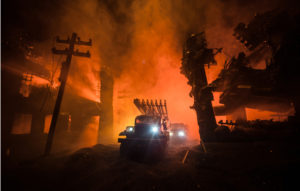Al Qassam Brigades, a militant wing of the Palestinian group Hamas, and the Palestinian Islamic Jihad (PJI), have been attempting to overwhelm Israel’s Iron Dome System with sheer volume. The militant groups have fired more than 2,800 rockets at cities and towns in Israel. Yaroslav Trofimov and Felicia Schwartz of the WSJ report that Iron Dome is maintaining a 90% kill rate during the recent barrage. They write:
On Sunday afternoon, as air-raid sirens sounded across this southern Israeli city, people abandoned cars in the middle of the road and ran to seek shelter. Hiding under a tree, a man tried to comfort his teenage daughter.
“Don’t worry,” he said, “it will be fine, the Iron Dome will save us.”
As he spoke, the Iron Dome’s air-defense interceptor missiles streaked into the intense blue sky, making six rockets fired at Ashkelon by the Palestinian Islamist movement Hamas explode into faraway white puffs. As in the majority of cases since Hamas started raining rockets on Israel on Monday—a total of 2,800 by now—there were no casualties or major damage.
Deployed since 2011 and built and maintained with $1.6 billion in U.S. funding, the Iron Dome system consists of a network of connected batteries and radars that fire at rockets that seem to be heading to populated areas and ignore those likely to fall into empty fields. While the system has been used in previous conflicts with Hamas, the Palestinian group has never fired as many rockets simultaneously.
Tweet Embed:
Video showing HAMAS utilizing a “Multiple Launch Rocket System” towards #Israel. pic.twitter.com/cstUJ983v3
— Global: MilitaryInfo (@Global_Mil_Info) May 12, 2021
[…] Iron Dome is managing to destroy some 90% of the incoming volleys, in line with expected performance, according to the Israeli military.
“Everyone has been quietly impressed by the ability of Iron Dome to handle the sheer volume,” said Michael Stephens, a senior fellow at the Foreign Policy Research Institute in Philadelphia. “It’s been a good demonstration of how the system has rapidly improved to become the best short-range system on the planet.” […]
“I suspect this will give Israeli missile defense systems a boost on the international market because it is certainly visually spectacular,” said Justin Bronk, research fellow for air power at the Royal United Services Institute, a defense think tank in London. […]
In peacetime, the Iron Dome system usually utilizes two missiles at a time to intercept incoming rockets, but now that Israel and Hamas are in a high-intensity conflict Israel has shifted to using one interceptor per one rocket, an Israeli Air Force general said. “You don’t intercept 140 missiles with 280,” the general said, describing Israel’s response to the largest barrage so far, 140 missiles that were aimed at Tel Aviv on Thursday.
Iron Dome now also has the ability to down Hamas drones, so far hitting three of them, including one on Saturday that headed for Reim, where an Israeli division headquarters is located. The Israeli general said the adjustment of the system, targeting a drone that can move horizontally, is a significant technological achievement. Israel, he added, hasn’t asked the U.S. for more Iron Dome interceptor missiles but has ordered the country’s own defense industry to increase production.
The system has been built for a much larger-scale potential conflict with Lebanon’s Hezbollah militia, the general said, and therefore the military doesn’t assess it in danger of running out of interceptor missiles anytime soon. Hezbollah has some 130,000 rockets, while Hamas and Palestinian Islamic Jihad had 13,000 rockets in Gaza a week ago, according to Israeli military estimates.
Iron Dome has the capacity to launch some 800 interceptors at a given time, making it hard for Hamas to overwhelm the system, Mr. Bronk of the Royal United Services Institute said. The current success, however, doesn’t mean that Israel should be complacent about the far more potent threat posed by Hezbollah’s arsenal.
Read the full article here.
Steve Schneider
Latest posts by Steve Schneider (see all)
- New Chinese Electromagnetic Surveillance Leaves “Nowhere to Hide” on Battlefield - March 15, 2024
- Amazon’s Nuclear Powered Data Center - March 7, 2024
- Skunk Works Rolls Out An Engineering Marvel - March 6, 2024
- Future of Airpower Takes First Flight - March 4, 2024
- A War Beneath the Waves – Trillions of Dollars at Stake - February 9, 2024















